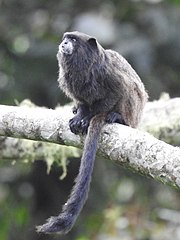| Common name
|
Scientific name and subspecies
|
Range
|
Size and ecology
|
IUCN status and estimated population
|
| Cruz Lima's saddle-back tamarin
|
Leontocebus cruzlimai
(Hershkovitz, 1966)
|
Brazil

|
Size:
Habitat: Area near the Inauini River
Diet:
|
LC
|
| Brown-mantled tamarin or Spix's saddle-back tamarin

|
Leontocebus fuscicollis
(Spix, 1823)
- L. f. avilapiresi, Avila Pires' saddle-back tamarin
- L. f. fuscicollis, Spix's saddle-back tamarin
- L. f. mura, Mura's saddleback tamarin
- L. f. primitivus, Lako's saddleback tamarin
|
Bolivia, Brazil and Peru.

|
Size:
Habitat: the Andes Mountains throughout the Amazon River Basin, they tend to inhabit primary and secondary lowland tropical forests.
Diet:
|
LC
|
| Lesson's saddle-back tamarin

|
Leontocebus fuscus
(Pucheran, 1845)
|
Peru (Amazonas)
|
Size:
Habitat:
Diet:
|
NT
|
| Illiger's saddle-back tamarin

|
Leontocebus illigeri
(Lesson, 1840)
|
Colombia (Plaines de Mocoa, Putumayo, between the Rio Putumayo and Rio Caqueta), Brazil
|
Size:
Habitat:
Diet:
|
LC
|
| Red-mantled saddle-back tamarin

|
Leontocebus lagonotus
(Jiménez de la Espada, 1870)
|
Ecuador and Peru
|
Size:
Habitat:
Diet:
|
LC
|
| Andean saddle-back tamarin

|
Leontocebus leucogenys
(Gray, 1866)
|
Peru (Huanuco)
|
Size:
Habitat:
Diet:
|
LC
|
| Black-mantled tamarin

|
Leontocebus nigricollis
(Spix, 1823)
- Spix's black mantle tamarin, Leontocebus nigricollis nigricollis
- Graells's tamarin or Graells’ black-mantle tamarin, Leontocebus nigricollis graellsi
- Hernandez-Camacho's black-mantle tamarin, Leontocebus nigricollis hernandezi
|
western Brazil, southeastern Colombia, north-eastern Peru and eastern Ecuador.

|
Size:
Habitat:
Diet:
|
LC
|
| Geoffroy's saddle-back tamarin
|
Leontocebus nigrifrons
(I. Geoffroy Saint-Hilaire, 1850)
|
Peru
|
Size:
Habitat:
Diet:
|
LC
|
| Golden-mantled tamarin or Golden-mantled saddle-back tamarin

|
Leontocebus tripartitus
(Milne-Edwards, 1878)
|
Ecuador and Peru(Amazon), Ecuador, and Northeast Peru (between the Rio Curaray and Rio Napo).
|
Size:
Habitat:
Diet:
|
NT
|
| Weddell's saddle-back tamarin

|
Leontocebus weddelli
(Deville, 1849)
- Leontocebus weddelli weddelli
- Crandall's saddle-back tamarin, (Leontocebus weddelli crandalli)
- White-mantled tamarin or White saddle-back tamarin, (Leontocebus weddelli melanoleucus)
|
Brazil, Bolivia and Peru
|
Size:
Habitat:
Diet:
|
LC
|